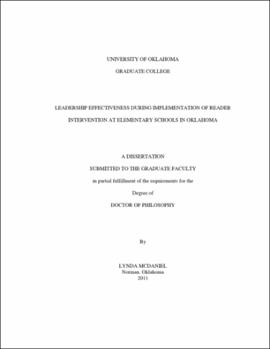| dc.contributor.advisor | Garn, Gregg | |
| dc.creator | McDaniel, Lynda Sue | |
| dc.date.accessioned | 2019-06-05T21:20:30Z | |
| dc.date.available | 2019-06-05T21:20:30Z | |
| dc.date.issued | 2011 | |
| dc.identifier | 9988595902042 | |
| dc.identifier.uri | https://hdl.handle.net/11244/320315 | |
| dc.description.abstract | The magnitude of students attending schools today that demonstrate reading difficulty in the earliest of years continues to grow throughout the United States. Compelling research indicates that children who get off to a poor start tend to remain behind in reading (Juel, 1998; Mead, 2010; CIREA, 2001). The reauthorization of the Individuals with Disabilities Education Act (IDEA, 2006) coupled with No Child Left Behind (NCLB, 2001) emphasizes necessary improvements in special education as well as general education requiring curricula and instructional tools that demonstrate proven effectiveness. Through these endeavors "Response to Intervention" (RtI) has been recommended as a model of instructional delivery to students who fail to meet the minimum requirements in reading achievement. | |
| dc.description.abstract | A quantitative approach (Creswell, 2009) was used to explore the effectiveness of leadership behaviors of school principals using the Principal Leadership Questionnaire ([PLQ], Leithwood & Jantzi, 1996; Valentine & Lucas, 2000) at 6 Oklahoma elementary schools and correlate results with the reading achievement of first-, second-, and third-grade at-risk students in each selected elementary school using the RtI model. The independent variables for this study included PLQ total scores and the three grade levels (first through third). Other related covariates\' were grade level and gender of students receiving reading intervention (RtI). The dependent variables were two aggregated DIBELS scores (beginning of the year and ending of the year). | |
| dc.description.abstract | Students defined as at-risk failed to meet designated benchmarks on either the beginning of the year and the end of the year Dynamic Indicators of Basic Early Literacy Skills (DIBELS, Institute for the Development of Educational Achievement [Institute], 2002) assessments. Student assessment data for 1,038 students was collected and analyzed to determine the success of the reading initiative and its relationship to the Principal Leadership Questionnaire. Student scores were correlated to the perceptions the teachers held of their principal\'s behavior questionnaire (PLQ). A significant negative correlation was found (r = -.09, r2 = .01, p < .005) when the student\'s reading achievement was correlated to the total principal leadership score. Achievement was positively related to student grade level (r = .10, r2 =.01, p < .005) but not related to the student\'s gender (r = -.02, r2 = .00, p = .45). | |
| dc.format.extent | 141 pages | |
| dc.format.medium | application.pdf | |
| dc.language | en_US | |
| dc.relation.requires | Adobe Acrobat Reader | |
| dc.subject | Elementary school principals--Oklahoma | |
| dc.subject | Educational leadership | |
| dc.subject | Reading (Primary) | |
| dc.title | Leadership Effectiveness During Implementation of Reader Intervention at Elementary Schools in Oklahoma | |
| dc.type | text | |
| dc.type | document | |
| dc.thesis.degree | Ph.D. | |
| ou.group | Jeannine Rainbolt College of Education::Department of Educational Leadership and Policy Studies | |
